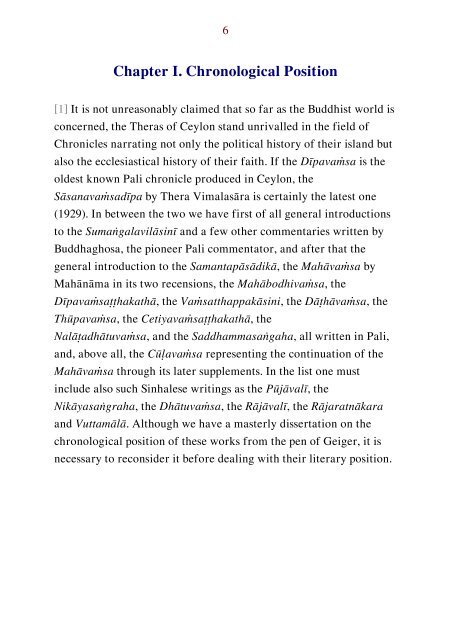On the Chronicles of Ceylon
A judicious appraisal of the various Chronicles that were written in Sri Lanka, assessing their chronology, literary and historical character.
A judicious appraisal of the various Chronicles that were written in Sri Lanka, assessing their chronology, literary and historical character.
- No tags were found...
You also want an ePaper? Increase the reach of your titles
YUMPU automatically turns print PDFs into web optimized ePapers that Google loves.
6<br />
Chapter I. Chronological Position<br />
[1] It is not unreasonably claimed that so far as <strong>the</strong> Buddhist world is<br />
concerned, <strong>the</strong> Theras <strong>of</strong> <strong>Ceylon</strong> stand unrivalled in <strong>the</strong> field <strong>of</strong><br />
<strong>Chronicles</strong> narrating not only <strong>the</strong> political history <strong>of</strong> <strong>the</strong>ir island but<br />
also <strong>the</strong> ecclesiastical history <strong>of</strong> <strong>the</strong>ir faith. If <strong>the</strong> Dīpavaṁsa is <strong>the</strong><br />
oldest known Pali chronicle produced in <strong>Ceylon</strong>, <strong>the</strong><br />
Sāsanavaṁsadīpa by Thera Vimalasāra is certainly <strong>the</strong> latest one<br />
(1929). In between <strong>the</strong> two we have first <strong>of</strong> all general introductions<br />
to <strong>the</strong> Sumaṅgalavilāsinī and a few o<strong>the</strong>r commentaries written by<br />
Buddhaghosa, <strong>the</strong> pioneer Pali commentator, and after that <strong>the</strong><br />
general introduction to <strong>the</strong> Samantapāsādikā, <strong>the</strong> Mahāvaṁsa by<br />
Mahānāma in its two recensions, <strong>the</strong> Mahābodhivaṁsa, <strong>the</strong><br />
Dīpavaṁsaṭṭhakathā, <strong>the</strong> Vaṁsatthappakāsini, <strong>the</strong> Dāṭhāvaṁsa, <strong>the</strong><br />
Thūpavaṁsa, <strong>the</strong> Cetiyavaṁsaṭṭhakathā, <strong>the</strong><br />
Nalāṭadhātuvaṁsa, and <strong>the</strong> Saddhammasaṅgaha, all written in Pali,<br />
and, above all, <strong>the</strong> Cūḷavaṁsa representing <strong>the</strong> continuation <strong>of</strong> <strong>the</strong><br />
Mahāvaṁsa through its later supplements. In <strong>the</strong> list one must<br />
include also such Sinhalese writings as <strong>the</strong> Pūjāvalī, <strong>the</strong><br />
Nikāyasaṅgraha, <strong>the</strong> Dhātuvaṁsa, <strong>the</strong> Rājāvalī, <strong>the</strong> Rājaratnākara<br />
and Vuttamālā. Although we have a masterly dissertation on <strong>the</strong><br />
chronological position <strong>of</strong> <strong>the</strong>se works from <strong>the</strong> pen <strong>of</strong> Geiger, it is<br />
necessary to reconsider it before dealing with <strong>the</strong>ir literary position.


















